Research on the Optimal Operation Method of DC Microgrid Base on the New DC Power Distribution Management System
Abstract
:1. Introduction
2. DC Power Distribution Management System
2.1. The Operating Goal of the DC Power Distribution Management System
2.2. Distributed Energy Sources Output Model
2.3. BES Model
2.4. Demand Response Model
3. Dynamic Optimal Load Flow Model of AC Distribution Network
4. Case Studies
5. Conclusions
- The architecture and model of the DC power distribution management system have been established to coordinate the dispersive DC microgrids in real time, optimize the scheduling of DG, and achieve the economic operation of the DC power distribution management system.
- The DC power distribution management system that can carry out the unified allocation of the interchange power between all the DC microgrids and the AC distribution networks, together with the reactive power compensation equipment SVC, has been used to achieve load flow optimization of the power distribution network. The method proposed in this paper can effectively reduce the power distribution network loss.
- As far as the utilization of renewable energies is concerned, the real-time optimization control via the DC power distribution management system can effectively avoid a series of problems caused by fluctuations in the output of renewable energies, greatly reducing the level of wind abandonment in centralized wind farms.
Author Contributions
Funding
Acknowledgments
Conflicts of Interest
Nomenclature
| Abbreviations | |
| DC | direct current |
| MMC | modular multilevel converter |
| AC | alternating current |
| PV | photovoltaics |
| WT | wind turbine |
| MT | Micro-turbine |
| DG | distributed generation |
| BES | battery-type energy storage |
| MPPT | maximum power point tracking |
| Parameters and Variables | |
| CMG | total cost of each microgrid dispatching |
| CMMC | DC power distribution management system purchases electricity from the upper stage power grid through MMC (including MMC loss cost) |
| number of the DC microgrids | |
| n | number of MMC |
| L | number of unit periods based on the complete scheduling period |
| electricity price at time t | |
| cDG | unit operating cost for the DG (here mainly refers to the operating costs of controllable DG) (MT) |
| actual active power of controllable DG in k-th DC microgrid at time t | |
| ccut | unit cost cutting for controlled load. |
| actual active power extraction of the controllable load in the k-th DC microgrid | |
| transmission power of the g-th MMC at time t (it is positive for the flowing from the distribution network into the DC power distribution management system, and negative otherwise) | |
| active loss for g-th MMC | |
| loss coefficient of MMC | |
| AC-side active power of MMC in the g-th node of the distribution network at time t | |
| AC-side reactive power of MMC in the g-th node of the distribution network at time t | |
| DC-side active power of MMC in the g-th node of the distribution network at time t | |
| predicted power of PV power in the k-th DC microgrid at time t | |
| PMT | capacity of the micro gas turbine in the k-th DC microgrid |
| limit of climbing speed | |
| discharge power of BES in the k-th DC microgrid at time t | |
| charge power of BES in the k-th DC microgrid at time t | |
| maximum discharge power of BES in the k-th DC microgrid at time t | |
| maximum charging power of BES in the k-th DC microgrid at time t | |
| state variable of BES discharge in the k-th DC microgrid at time t | |
| state variable of BES discharge in the k-th DC microgrid at time t | |
| demand-side response of operation state of the controllable load in the k-th DC microgrid at time t | |
| * | maximum power extraction of the curtailment-enabled load in k-th DC microgrid |
| minimum up-time of load curtailment | |
| maximum up-time for load curtailment. | |
| Ui(t) | voltages of i-th and j-th node at time t |
| yij | admittance between i-th and j-th node |
| upper limits of the SVC adjustable reactive power connected to the i-th node. | |
| lower limits of the SVC adjustable reactive power connected to the i-th node. | |
| u(j) | the set of the head end nodes of the branch circuit with the j as the end node in the distribution network |
| v(j) | the set of the end nodes of the branch circuit with the j as the head end node in the distribution network |
| Pij(t) | active power at the head end of the branch circuit ij at time t |
| Qij(t) | reactive power at the head end of the branch circuit ij at time t |
| Pj(t) | net injection values of active power of node j at time |
| Qj(t) | net injection values of reactive power of node j at time |
| Iij(t) | current amplitude of branch circuit ij at time t |
| Qj(t) | active power sent by the upper power generator on node i |
| rij | resistance of the branch circuit ij |
| xij | reactance of the branch circuit ij |
| upper limits of the voltage amplitude of the node i | |
| lower limits of the voltage amplitude of the node i | |
| upper limit of the amplitude of the current of the branch circuit ij; | |
| P0(t) | active power flowing from the root node to the AC distribution network at time t |
| Q0(t) | reactive power flowing from the root node to the AC distribution network at time t |
| upper limits of the active power of the root node gateway of the AC distribution network | |
| lower limits of the active power of the root node gateway of the AC distribution network | |
| upper limits of the reactive power of the root node gateway of the AC distribution network | |
| lower limits of the reactive power of the root node gateway of the AC distribution network | |
References
- Li, X.; Guo, L.; Wang, C.; Li, Y. Key technologies of DC microgrids: An overview. Proc. CSEE 2016, 36, 2–17. [Google Scholar]
- Jiang, D.; Zheng, H. Research status and developing prospect of DC distribution network. Autom. Electr. Power Syst 2012, 36, 98–104. (In Chinese) [Google Scholar]
- Dragicevic, T.; Vasquez, J.C.; Guerrero, J.M.; Skrlec, D. Advanced LVDC electrical power architectures and microgrids: A step toward a new generation of power distribution networks. IEEE Electrif. Mag. 2014, 2, 54–65. [Google Scholar] [CrossRef] [Green Version]
- Xiangjun, L.; Shangxing, W.A.; Dong, H. Summary and prospect of operation control and application method for battery energy storage systems. Power Syst. Technol. 2017, 41, 3315–3325. [Google Scholar]
- Jichen, L.; Ma, H.; Hui, D. Present development condition and trends of energy storage technology in the integration of distributed renewable energy. Trans. China Electrotech. Soc. 2016, 31, 1–10. [Google Scholar]
- Song, Q.; Zhao, B.; Liu, W.; Zeng, R. An overview of research on smart dc distribution power network. Proc. CSEE 2013, 33, 9–20. (In Chinese) [Google Scholar]
- Chaudhary, S.K.; Guerrero, J.M.; Teodorescu, R. Enhancing the Capacity of the AC Distribution System Using DC Interlinks—A Step Toward Future DC Grid. IEEE Trans. Smart Grid. 2015, 6, 1722–1729. [Google Scholar] [CrossRef]
- Zhang, C.; Peng, K.; Xu, B.; Chen, Y.; Zhao, Y.; Zhao, Y. Feasible power flow solution and voltage stability analysis method for DC distribution system. Autom. Electr. Power Syst. 2018, 42, 48–53. [Google Scholar]
- Huang, J.; Wei, C.; Wen, A. Hierarchical coordinated control strategy for flexible DC distribution network considering uncertainties of source and load. Autom. Electr. Power Syst. 2018, 42, 101–112. [Google Scholar]
- Xie, D.; Chen, A.; Yu, S.; Lu, Y.; Gu, C.; Li, Y. Research on Synthetic Scheduling Index and Scheduling Strategy of Multiport Flexible DC Distribution Network with Droop-control. Proc. CSEE 2019, 10, 1–10. (In Chinese) [Google Scholar]
- XU, Y.; AI, Q. Coordinated optimal dispatch of active distribution network with microgrids. Electr. Power Autom. Equip. 2016, 36, 18–26. [Google Scholar]
- Zhang, X.; Niui, H.; Zjao, J. Optimal dispatch method of distribution network with microgrid. Trans. China Electrotech. Soc 2017, 32, 165–173. (In Chinese) [Google Scholar]
- Qi, C.; Wang, K.; Li, G.; Han, B.; Xu, S.; Wei, Z. Hierarchical and Distributed Optimal Schedulin of AC/DC Hybrid Active Distribution Network. Proc. CSEE 2017, 37, 1909–1917. (In Chinese) [Google Scholar]
- Ma, Z.; Zhou, X.; Shang, Y.; Zhou, L. Form and development trend of future distribution system. Proc. CSEE 2015, 35, 1289–1298. (In Chinese). [Google Scholar]
- Ma, X.; Qu, H.; Pei, W.; Xiao, H. Optimal interactive operation of microgrid under demand respone. Adv. Technol. Electr. Eng. Energy 2017, 36, 71–79. [Google Scholar]
- Liu, Y.; Wu, W.; Zhang, B.; Li, Z.; Li, Z. A mixed integer second-order cone programming based active and reactive power coordinated multi-period optimization for active distribution network. Proc. CSEE 2014, 34, 2575–2583. (In Chinese) [Google Scholar]
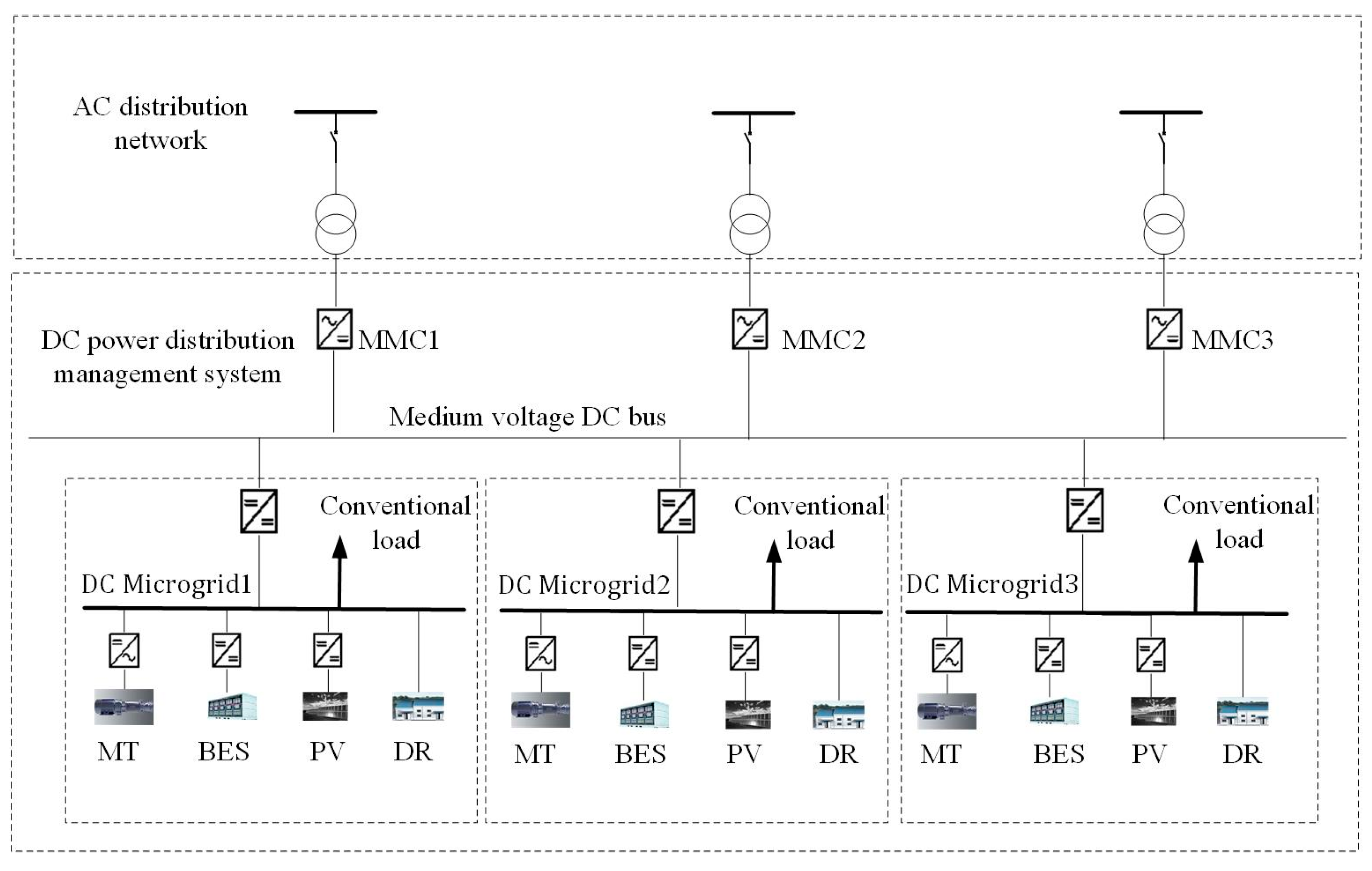
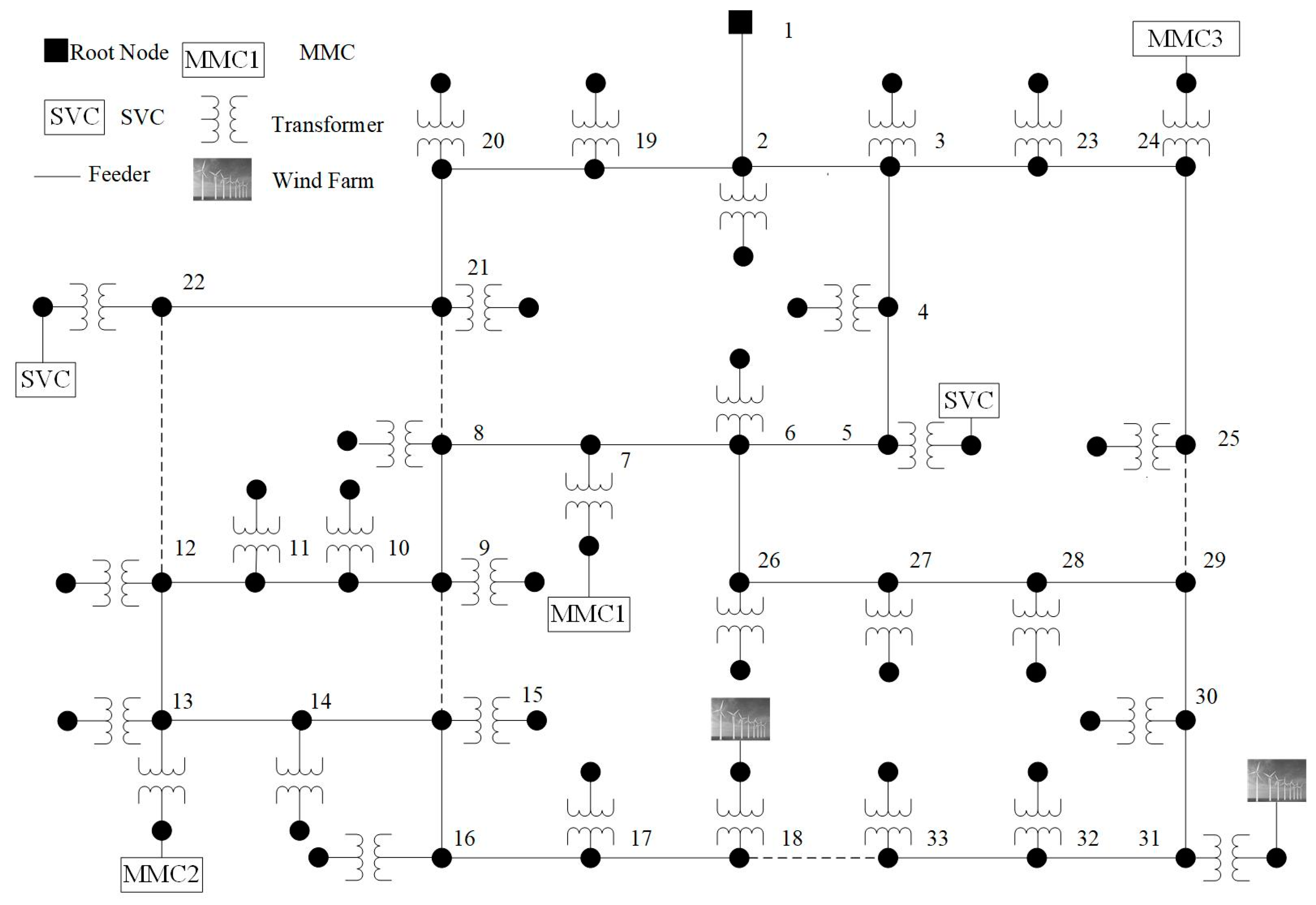
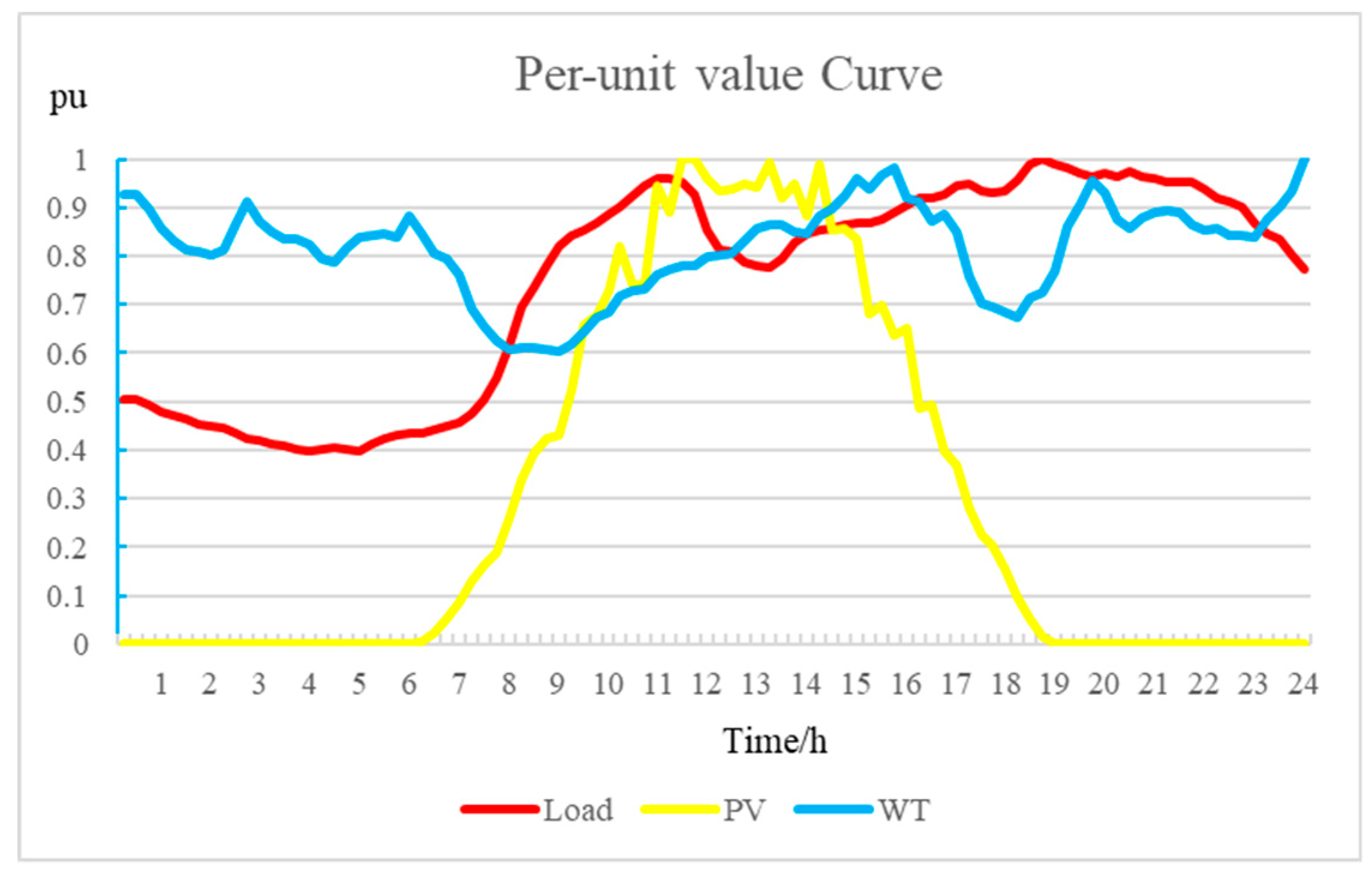

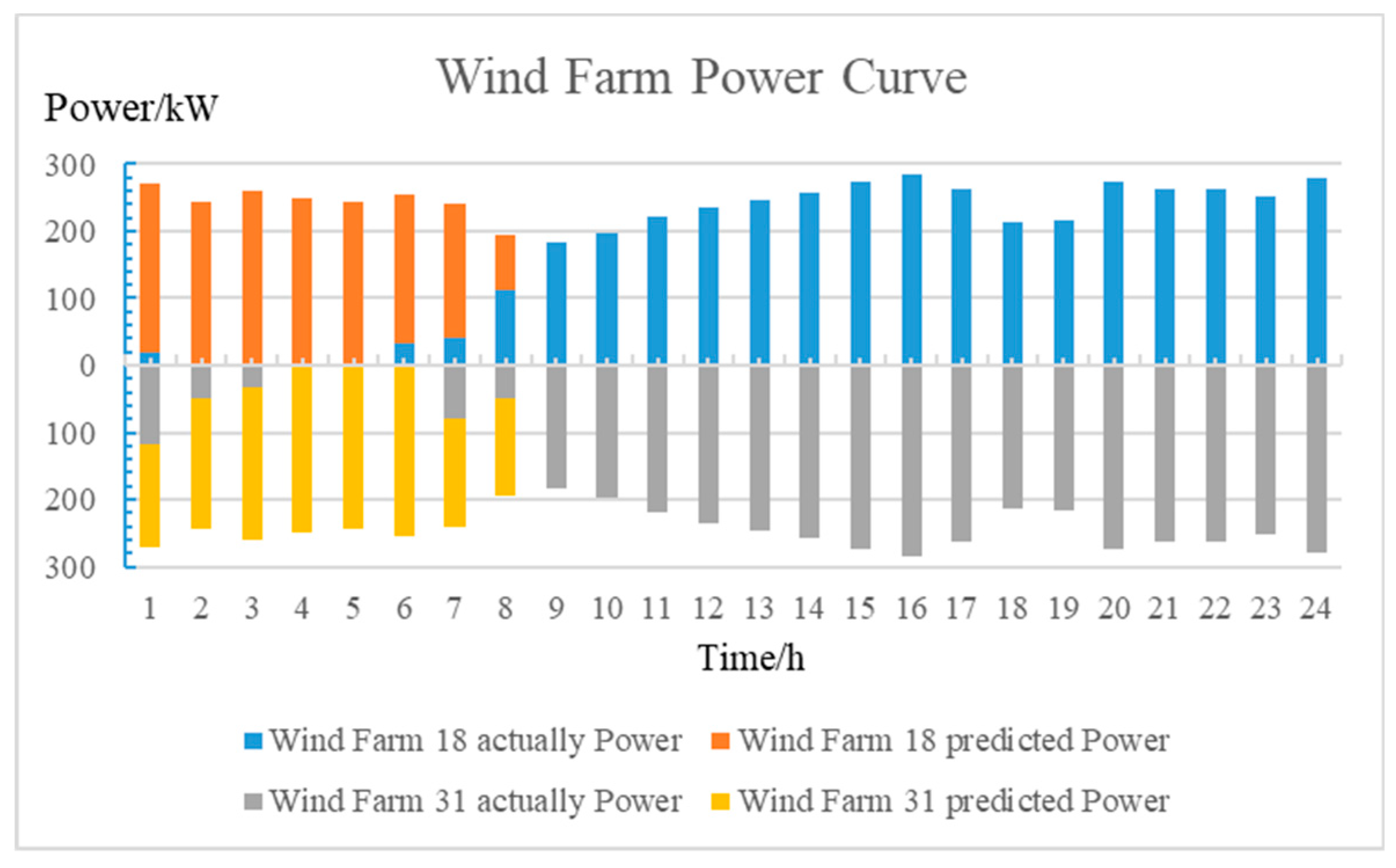
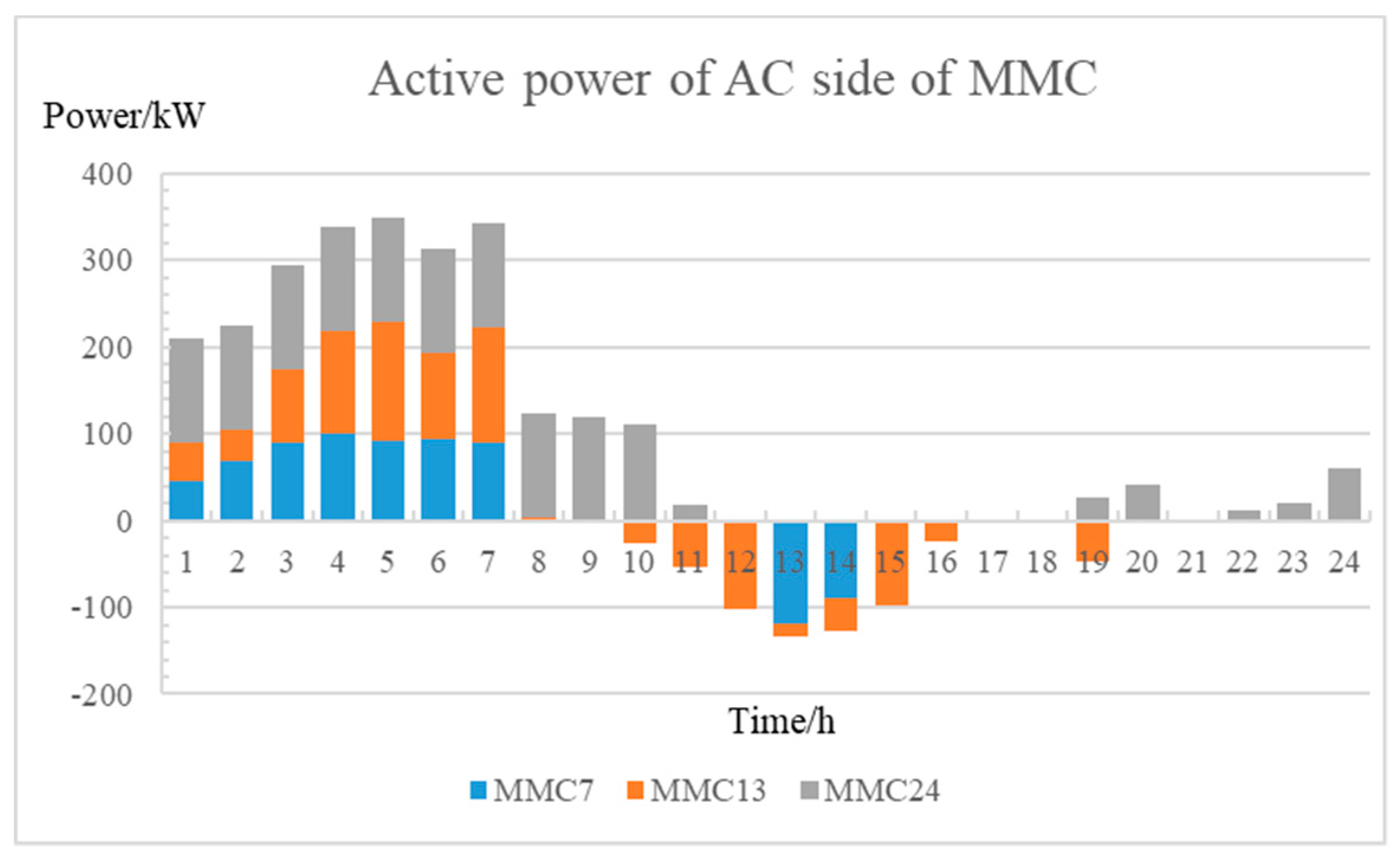
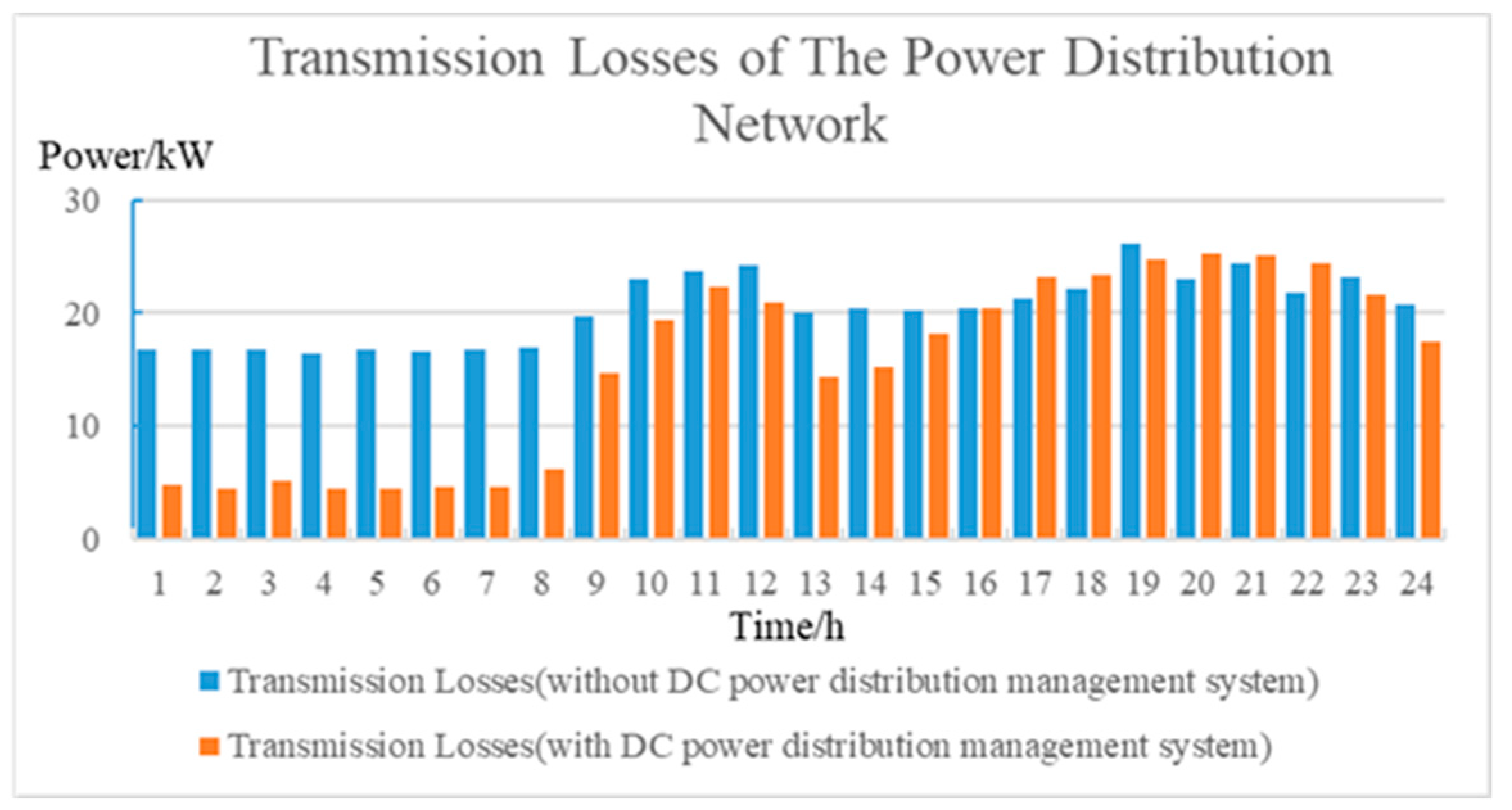
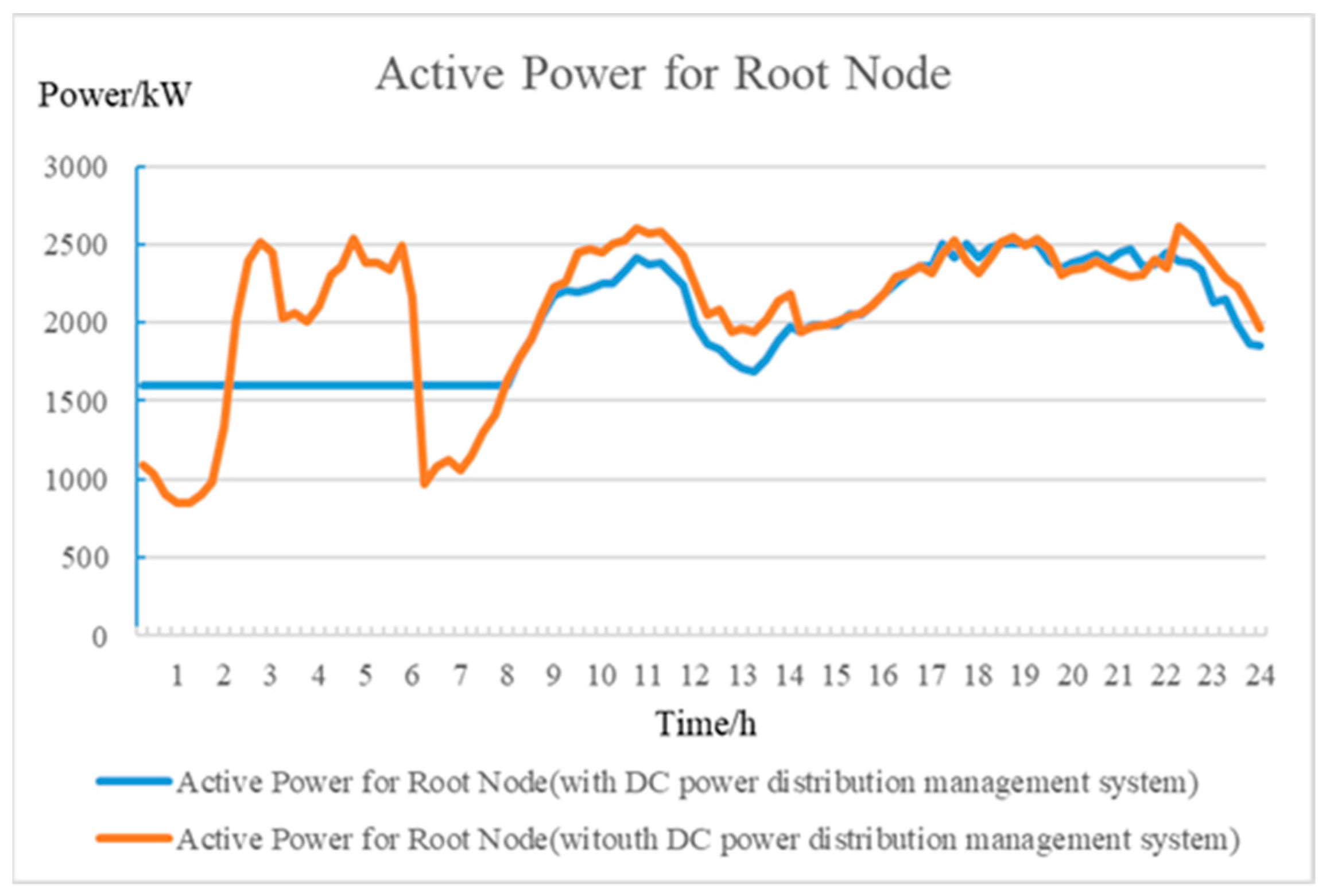

| DC Microgrid | Microgrids Capacity/KW | PV Power/KW | BES Power/KW | BES Capacity/KW | MT Power/kw | Demand-Side Response Power/KW |
|---|---|---|---|---|---|---|
| MG1 | 100 | 100 | 80 | 400 | 30 | 15 |
| MG2 | 120 | 80 | 60 | 300 | 20 | 15 |
| MG3 | 80 | 120 | 120 | 600 | 40 | 20 |
© 2019 by the authors. Licensee MDPI, Basel, Switzerland. This article is an open access article distributed under the terms and conditions of the Creative Commons Attribution (CC BY) license (http://creativecommons.org/licenses/by/4.0/).
Share and Cite
Peng, Q.; Yuan, Z.; Ouyang, B.; Guo, P.; Qu, L. Research on the Optimal Operation Method of DC Microgrid Base on the New DC Power Distribution Management System. Electronics 2020, 9, 9. https://doi.org/10.3390/electronics9010009
Peng Q, Yuan Z, Ouyang B, Guo P, Qu L. Research on the Optimal Operation Method of DC Microgrid Base on the New DC Power Distribution Management System. Electronics. 2020; 9(1):9. https://doi.org/10.3390/electronics9010009
Chicago/Turabian StylePeng, Qingwen, Zhichang Yuan, Bin Ouyang, Peiqian Guo, and Lu Qu. 2020. "Research on the Optimal Operation Method of DC Microgrid Base on the New DC Power Distribution Management System" Electronics 9, no. 1: 9. https://doi.org/10.3390/electronics9010009





